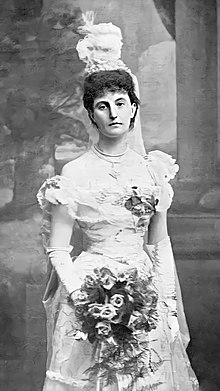Winifred, Countess of Dundonald
| Winifred (Bamford-Hesketh) Cochrane | |
|---|---|
| Winifred, Countess Of Dundonald. | |
 | |
| Born | 16 April 1859 Devon, England |
| Died | 16 January 1924 (aged 64) London, England |
| Spouse | Douglas Mackinnon Baillie Hamilton Cochrane (1852 – 1935) |
| Issue | |
| House | Dundonald (by marriage) |
| Father | Robert Bamford Hesketh |
| Mother | Ellen Jones-Bateman |
Winifred Cochrane, Countess of Dundonald (Welsh; Winifred, Iarlles Dundonald); Born 16 April 1859 was the Welsh[1][2] wife of Douglas Mackinnon Baillie Hamilton Cochrane (1852 – 1935).
Ancestry
Second daughter and sole heir of Robert Bamford Hesketh and Ellen Jones-Bateman, Winifred was born into the royal house of Marchudd ap Cynan, the founder of the VIII Noble Tribe of North Wales. Cynan’s descendants, the Lloyds of Plas yn y Gwrych were based in the Parish of Abergele, where Winifred, through her ancestors shared co-sanguinity with Llywelyn the Great.[3]
Personal Life
Growing up, Winifred Bamford Hesketh lived at her family’s residences in London, Torquay and Gwyrch Castle. She married Lieutenant General Douglas Mackinnon Baillie Hamilton Cochrane, 12th Earl of Dundonald in 1878, when she was 19 years old.
When Winifred turned 21, the money in her Trust Fund became available and a house was purchased in London. She had five children between 1880 and 1893.[4]
The marriage is thought to have been an unhappy one. The Earl spent most of his time in Scotland while the Countess remained in Wales.
Gwrych Castle
The countess inherited Gwrych Castle, the seat of the Bamford-Hesketh family on the death of her father in 1894.
In 1919, she sold some of the old buildings on the estate, along with the Llanddulas limestone quarry and some mines.
In her will, she bequeathed Gwrych to Prince George, later King George V, who was unable to accept the gift and sold the castle. It was later re-purchased by her husband the Earl of Dundonald for £70,000.[5]
Welsh Heritage
The countess was a Welsh speaker and a patron of Welsh art, music and literature.
In the early 1900s she founded a North Wales Harp competition. She was inducted as a bard at the National Eisteddfod of 1913.
Winifred was interested in archaeology and involved with the Abergele Historical and Cambrian Societies. She allowed excavations on ancient monuments she owned and financed the publication of their findings.[6]
Charitable works
Knowing how vulnerable local poor people would be during the winter months, Winifred would often donate firewood from the fell at her properties to keep them warm.
The countess had a church hall built for the village of Llanddulas in 1909.
On her death she bequeathed £5000 and a piece of land for building almshouses houses in Groes Lwyd, Abergele.[7] She also bequeathed the whole Gwyrch estate to the Welsh Church.
References
- ^ "--.--THE NATIONAL EISTEDDFOD EXHIBITION.|1910-09-01|The Welsh Coast Pioneer and Review for North Cambria - Welsh Newspapers". newspapers.library.wales.
- ^ "LORD COCHRANE^ COMING OF AGE.¡|1907-11-02|Llandudno Advertiser and List of Visitors - Welsh Newspapers". newspapers.library.wales.
- ^ http://discoveringoldwelshhouses.co.uk/library/Hhistory/con%20163_HH_54_HenWrych.pdf
- ^ "Discovering Welsh Houses" (PDF).
{{cite web}}: CS1 maint: url-status (link) - ^ "The National Library of Wales".
{{cite web}}: CS1 maint: url-status (link) - ^ "Gwrych Castle".
{{cite web}}: CS1 maint: url-status (link) - ^ "Winifred Bamford Hesketh Almshouses".
{{cite web}}: CS1 maint: url-status (link)
This article needs additional or more specific categories. (February 2020) |
